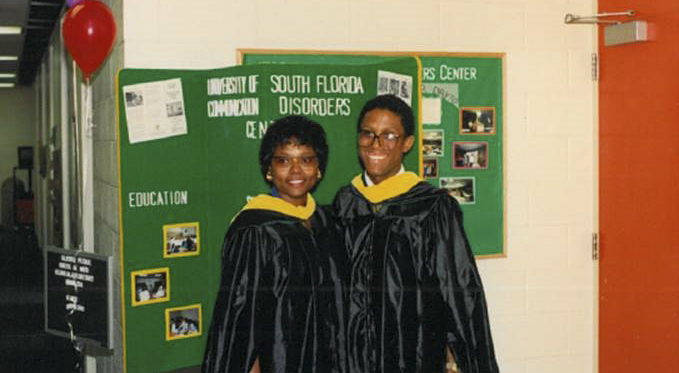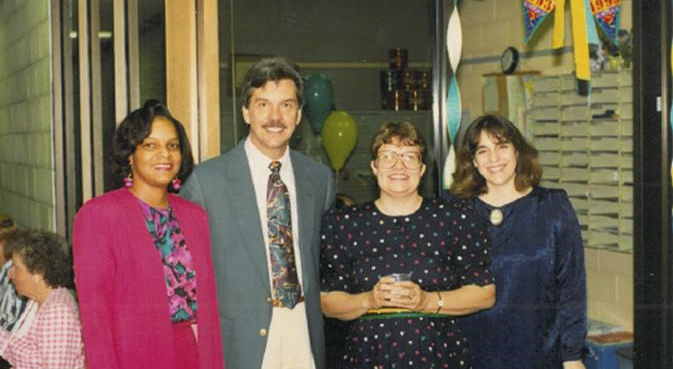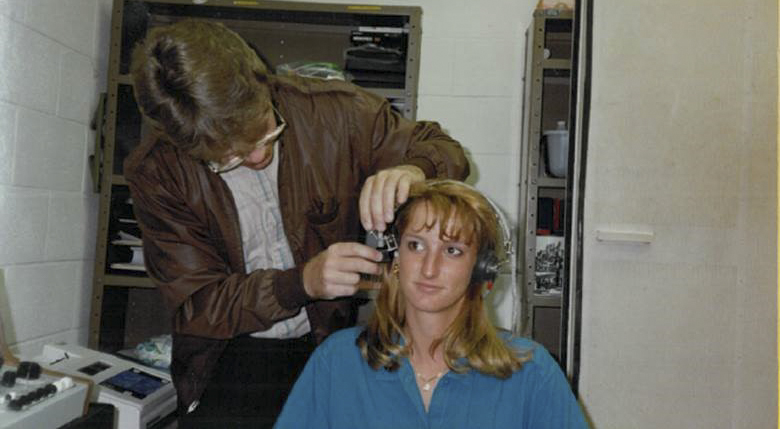At its founding, the University of South Florida’s Department of Communication Sciences & Disorders held classes in a former hotel, where students performed their clinical observations by peering through peepholes.
Today, CSD occupies nearly 50,000 square feet, in a building that bears its name, and encompasses three specialized clinics and a sign language interpretation service.
It is this growth, and a slew of other accomplishments, that CSD will celebrate this year, during its 50th anniversary.
“We have an amazing story to tell. We’ve grown into one of the largest audiology and speech-language pathology programs in the state, and we’re the only program of our kind in the country,” said Professor and Chair Jennifer Jones Lister, PhD.
“We are filling a niche here in our community, and our graduates are doing life-changing work in their careers. We have come a very long way in 50 years.”
Remembering “Mildew Manor”
The Department of Communication Sciences & Disorders (CSD), dedicated to translational and interdisciplinary research of all communication-related processes and conditions, started humbly, in an off-campus location nicknamed “Mildew Manor.”
“My classes were located in apartments on Fletcher Avenue. The building was a terrible green color just like my 1962 Volkswagen,” said Tom Ehren, a CSD alumnus who now works as a clinical instructor for Communication Sciences and Disorders at the University of Central Florida, in one of numerous oral histories CSD has collected in recognition of its golden anniversary.
“It was very ugly and old,” added alumnus Mark Algeo.

As it celebrates its 50th anniversary, USF's Department of Communication Sciences & Disorders is collecting oral histories and photos from throughout its history. Pictured above are alumni Cynthia Palk and Parrish Hill.
Algeo described a therapy room that was “partitioned into four rooms with plywood paneling … there was a little slit in the wood where the supervisor would look into the cubicle to see what the student was doing. That was the supervision method.”
Fortunately, “Mildew Manor” was only a place for CSD to start. By the 1970s, the department had a new home on the Tampa campus, inside the Behavioral Sciences (BEH) building. Those who remember the move are in agreement: It was a dramatic upgrade.
“There was a huge clinical observation room, the perimeter spanned five or six therapy rooms, so you could watch many sessions at once — I had never seen anything like this. I learned so much, and I really fell in love with the process of clinical supervision,” said Joseph Constantine, PhD, an alumnus who is now a professor of communication disorders at Eastern Kentucky University.
For a department that has been on a relentless upward trajectory since it began, it was only a matter of time before it would outgrow BEH. In 2001, it moved into its half of the Psychology/Communication Sciences & Disorders building on Laurel Drive.
In a 2001 interview with the Tampa Bay Times, architect Steven Gift described the building as “a clear connection between the medical complex and the core campus … a bridge between the two parts of campus.”
The move into the new building took place during the tenure of then-chair Arthur Guilford, PhD, who told the Times:
“The new building and its location within walking distance of Moffitt Cancer Center, the medical school, as well as buildings housing the departments of social work and physical science will enhance the experience for everyone. It will make ours the most dynamic program of its kind in the U.S.”
USF Vice Provost for Strategic Planning, Performance & Accountability Theresa Chisolm, PhD, also a former chair and current CSD professor, recounted that because Dr. Guilford was so instrumental during the construction of the new building, even contributing to its architectural design, students and faculty members honored his birthday by wearing shirts printed with, “Frank Lloyd Guilford,” a reference to famed architect Frank Lloyd Wright.
From One Degree — to Five
CSD’s physical growth paralleled gains in enrollment and expansions in its degree offerings.
Initially CSD, offered a five-year program that allowed students to complete both their bachelor’s and master’s degrees in speech-language pathology.
About 25 students enrolled in CSD’s first class.
“You came in and took five entry-level courses. Then you took the GRE and had to get a minimum score. If you passed the courses and got that score on the GRE, you got into the master’s program. A master’s thesis was required,”Algeo said.

Past Communication Sciences & Disorders faculty, from left, Linda Mack, Arthur Guilford, Carol Fernandez and current faculty member Nancy Muscato.
Today, the department offers the Bachelor of Arts in Communication Sciences & Disorders with concentrations in Speech-Language-Hearing Science, Interpreter Training and Deaf Studies; the Master of Science in Speech-Language Pathology, offered both face-to-face and online; Doctor of Audiology (AuD) and Doctor of Philosophy (PhD) in CSD; and a dual AuD/PhD degree.
More than 700 students are currently pursuing one of CSD’s degrees, making USF’s program one of the largest in the state, Dr. Lister said.
CSD stands out not only for its sheer size, but also for its unique curriculum. It is the only program in the nation to include both sign language and audiology.
As a practice, audiology is concerned with restoring, sustaining and improving hearing. Audiologists deal in hearing aids and cochlear implants, tweaking their settings to give patients back as much of their hearing as possible.
In some cases, however, patients or their families choose to forgo technology, accept the hearing loss and communicate through sign language.
These opposite-end-of-the-spectrum approaches to hearing loss do not naturally coexist, but USF has managed to do it within CSD — and it’s been to the students’ and the patients’ benefit, Dr. Lister said.
“Audiology and sign language students have some shared curriculum at the undergraduate level. We live in harmony and we have a healthier respect for each other,” said Dr. Lister, herself an audiologist. “It has made our students and faculty more culturally sensitive.”
Clinics for Professional Preparation
When it began, CSD was a unit within what is now the College of Arts and Sciences. In the early 2000s, it was shifted to the College of Behavioral and Community Sciences.
“It’s a better fit given the applied nature of our programs,” Dr. Lister said.
And nowhere is that “applied nature” more evident than in the USF Speech-Language Clinic, Bolesta Center at USF, USF Hearing Clinic, and Hands on USF, a sign language interpretation service.
“Each of our clinics is a model of the real world, allowing our students to train in real-world environments,” Dr. Lister said.
USF Speech-Language Clinic is itself approaching the 50-year mark, having been established in 1969.
“Through this clinic, we provide a wide range of services for the whole life span,” said Dr. Lister.

“We teach strategies to help the patient be able to achieve what is important to them. That might be, for instance, standing up in church to do a reading. It’s very patient-centered,” Dr. Lister said.
CSD also operates the USF Hearing Clinic, a full-service audiology practice offering hearing evaluations, hearing aid fittings and repairs, evaluations for auditory processing, tinnitus, and balance, and cochlear implant services for patients of all ages.
The Bolesta Center at USF, meanwhile, is exclusively dedicated to helping young children, teaching them to use their hearing aid or cochlear implant. It is one of the few clinics of its kind in the state providing bilingual services and home visits. During in-home sessions, USF speech-language pathology faculty members help the children and their families learn how to develop the children’s auditory and verbal systems.
A service not a clinic, Hands on USF provides sign language interpreters for events at USF and the broader community.
Combined, the three clinics and Hands on USF performed provided more than 30,000 hours of services in 2015-16.
The professional preparation students receive while working in CSD’s service enterprises no doubt contributes to the ongoing 100-percent employment rate of students in the master’s and AuD programs.
Research for the Future
True to the interdisciplinary and translational mission of USF, CSD, Chemical Engineering and Biomedical Engineering established the Global Center for Hearing & Speech Research in 2011 to develop solutions for hearing and speech deficiencies.
In a landmark discovery, researchers at the Global Center in 2012 identified a genetic biomarker for age-related hearing loss, and in 2016, received a $9 million National Institutes of Health grant to study age-related hearing loss treatments.
CSD researchers are also conducting numerous other grant-funded studies, including one with the Department of Defense that will result in an app to educate and help treat hearing loss in military personnel.
“We are making amazing advancements every day,” Dr. Lister said.
“But just as it’s been for 50 years, the reason for everything we do is to help people. We help grandmothers hear their grandchildren. We help people who haven’t heard birds sing for 20 years hear that beautiful sound again. If you can’t hear or speak, you lose your connection with people. That’s what we give back to people.”
CSD will mark its 50th anniversary with a variety of events, including a clay shooting event — complete with USF-branded earplugs —on Oct. 28 from 8 a.m. to 2 p.m. at Tampa Bay Sporting Clays in Land O’ Lakes. The event will be open to the public and will benefit the Bolesta Center at USF.
For more information on CSD, its history, clinics and research, visit usf.edu/cbcs/csd.
Story by Rachel Pleasant, University Communications & Marketing, photos provided by Communication Sciences & Disorders